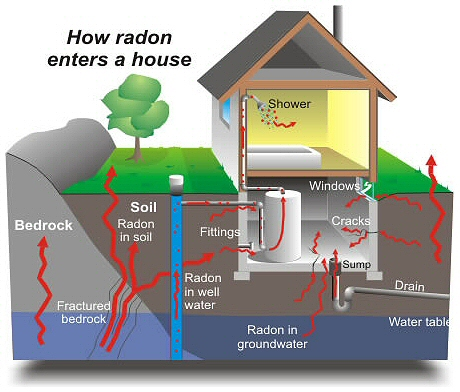Radon is a radioactive gas found naturally in the environment and is found across Canada. It is produced by the decay of uranium found in soil, rock or water. Radon is invisible, odourless and tasteless and emits ionizing radiation. As a gas, radon can move freely through the soil enabling it to escape to the atmosphere or seep into buildings. Radon levels are generally highest in basements and crawl spaces because these areas are nearest to the source and are usually poorly ventilated. Radon varies from home-to-home, building-to-building so just because your neighbor tested and has low levels, that doesn't mean your home isn't affected by radon. Some amount of radon is found in almost every home, but concentration levels will vary from one house to another, even if they are similar and next door to each other.
Radon can enter a home any place it finds an opening where the house contacts the soil: cracks in foundation walls and in floor slabs, construction joints, gaps around service pipes, support posts, window casements, floor drains, sumps or cavities inside walls. The only way to know if you have radon in your home, school, daycare or workplace is to TEST, TEST, TEST! Newly constructed homes in Manitoba after 2013 were required by law to rough-in for future radon ventilation but that does not mean those homes are deemed radon free. This just means those homes are ready for testing and mitigation if their levels are found to be elevated.
A Health Canada study confirmed radon levels vary significantly across the country. Manitoba, New Brunswick, Saskatchewan, and the Yukon had the highest percentages of participants homes which tested above the radon guidelines. Some of the highest levels were measured in Manitoba. Exposure to 400 Bq/m3 of radon for 8 hours is considered by radiation scientists to be equivalent to smoking a pack of cigarettes every day.



